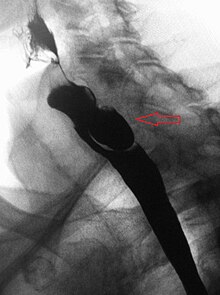Zenker's diverticulum
| Zenker's diverticulum | |
|---|---|
| Other names | Pharyngoesophageal diverticulum, pharyngeal pouch, hypopharyngeal diverticulum |
 | |
| Specialty | Gastroenterology |
A Zenker's diverticulum, also pharyngeal pouch, is a
). It is a pseudo diverticulum or false diverticulum (only involving the mucosa and submucosa of the esophageal wall, not the adventitia), also known as a pulsion diverticulum.It was named in 1877 after
Signs and symptoms
When there is excessive pressure within the lower
While traction and pulsion mechanisms have long been deemed the main factors promoting development of a Zenker's diverticulum, current consensus considers occlusive mechanisms to be most important: uncoordinated swallowing, impaired relaxation and spasm of the
While it may be asymptomatic, Zenker diverticulum can present with the following symptoms:
- Dysphagia (difficulty swallowing), and sense of a lump in the throat
- Food might get trapped in the outpouching, leading to:
- Regurgitation, reappearance of ingested food in the mouth
- Cough, due to food regurgitated into the airway
- Halitosis, smelly breath, as stagnant food is digested by microorganisms
- Infection
It rarely, if ever, causes any pain.
Esophageal webs are seen associated in 50% of patients with this condition.
Rarer forms of cervical esophageal diverticula are the
Diagnosis


A combination of the simple
Treatment
If small (ie, <2 cm) and asymptomatic, no treatment is necessary.
Other non-surgical treatment modalities also exist, such as endoscopic laser, which recent evidence suggests is less effective than stapling.[9]
Epidemiology
Zenker's diverticulum mainly affects older adults. It has an incidence of 2 per 100,000 per year in the UK, but there is significant geographical variation around the world.[10]
